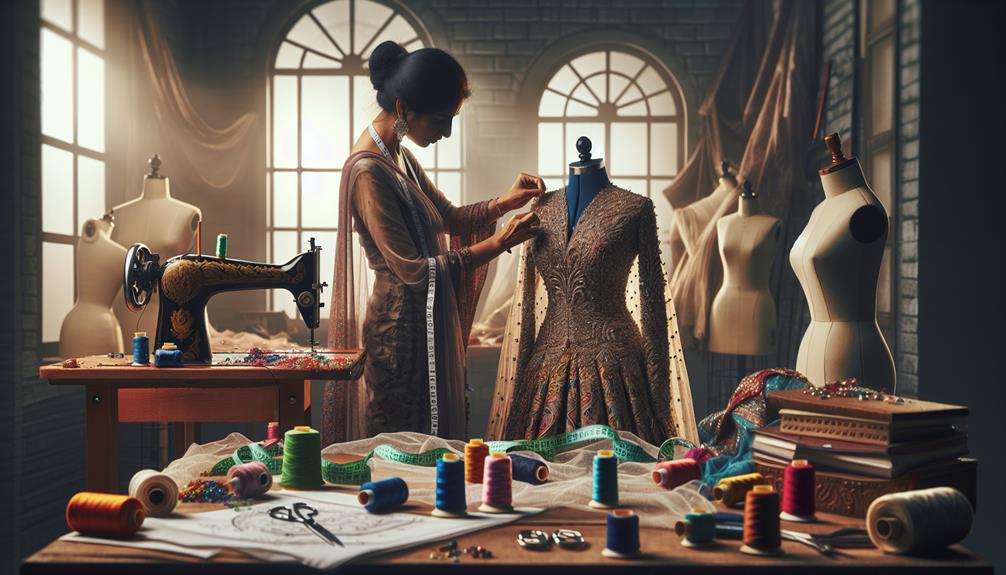So, did you know that on average, it takes about 2-4 weeks to tailor a dress? That's quite a range, right?
But before you start mentally calculating your wardrobe timeline, let me shed some light on what really determines how long the process might take.
From the intricacy of the alterations to the type of fabric used, there are several factors that play a role in the time it takes to tailor a dress.
Let's explore these variables further to better understand how to plan for your next tailor-made outfit.
Table of Contents
Key Takeaways
- Tailoring time varies based on complexity, tailor's skill, workload, and client communication.
- Dress style intricacy influences alteration duration and expertise required.
- Fabric type complexity impacts alteration time, especially with delicate or embellished materials.
- Skill level affects efficiency, with mastery reducing time needed for precise dress alterations.
Factors Affecting Tailoring Time
When determining how long it takes to tailor a dress, various factors come into play that can significantly impact the time needed for alterations.
The time taken for tailoring a dress can range from 2-3 days, depending on the complexity of the alterations required. Engaging a professional tailor with ample skill and experience is crucial for an efficient tailoring process.
The tailor's workload also plays a role; during busier times, such as peak seasons, completion time may be extended. To streamline the process and ensure a successful outcome, it's essential to schedule fittings regularly.
Effective communication between the client and the tailor can expedite the alteration process by addressing any concerns promptly. By considering these factors and maintaining open dialogue throughout the tailoring journey, both parties can work together towards achieving a beautifully tailored dress in a timely manner.
Dress Style Influence on Timing
Considering the influence of dress style on tailoring time, intricate designs or unique features often necessitate more extensive alterations. The complexity of a dress style can significantly impact the amount of time needed for alterations.
Here are three key points to understand how dress style influences the timing required for tailoring:
- Specific Style of the Dress: Different dress styles demand varying levels of expertise and time commitment from the tailor due to their design complexities. For example, a dress with intricate lace detailing or elaborate beadwork may require meticulous adjustments that take longer to complete.
- Complex Dress Styles: Certain dress styles, such as those with complex draping or structural elements, may necessitate additional processes like hanging, ironing, or seaming. These extra steps can extend the overall tailoring time needed to achieve the desired fit and look.
- Time Needed for Alterations: The attention to detail varies depending on the specific style of the dress, impacting the time required for alterations. Tailors carefully assess the readiness of the dress based on its style to determine the specific steps and amount of time needed for alterations.
Material Complexity and Alteration Duration
When it comes to tailoring a dress, the type of fabric plays a crucial role in determining the alteration duration.
Delicate fabrics like silk or chiffon often require meticulous handling, which can extend the tailoring process.
Materials such as sequined or beaded fabrics add complexity to alterations, demanding careful attention and potentially prolonging the time needed for adjustments.
Fabric Type Impact
Tailoring a dress may require varying durations dependent on the complexity of the fabric used. The type of fabric can significantly impact the time it takes to tailor a dress. Delicate fabrics like silk or chiffon demand meticulous attention, leading to extended alteration periods.
Similarly, complex materials such as lace or beaded fabrics require extra care to preserve their intricate design, further lengthening the tailoring process.
Certain fabrics like satin or tulle present their own challenges during alterations, affecting the overall time needed for adjustments.
- Delicate fabrics like silk or chiffon
- Complex materials such as lace or beaded fabrics
- Certain fabrics like satin or tulle
Tailoring Time Variations
When working with different fabric types for tailoring dresses, the time required for alterations can vary significantly based on the complexity of the material and the intricacy of the design.
For instance, when altering a wedding dress made of delicate lace or silk, the process may take longer due to the intricate nature of these fabrics.
The time needed to tailor a dress depends on the level of detail involved in the alterations. Factors such as hand sewing, special equipment requirements, and the need for specific techniques can all impact the duration of the tailoring process.
Therefore, the time it takes to complete alterations on a dress isn't fixed but rather adapts to the unique characteristics of the material being worked on.
Skill Level Required
Considering the complexity of materials and the duration of alterations, mastering different skill levels is vital in determining the time required to tailor a dress.
Skill Levels Impacting Tailoring Time:
- Fabric Expertise: Understanding how to work with various fabrics efficiently can significantly reduce the time needed for alterations.
- Equipment Proficiency: Being adept with specialized tools for different fabrics can streamline the tailoring process and decrease the overall time frame.
- Technique Mastery: Having a wide range of techniques at your disposal allows for quicker and more precise alterations, ultimately shortening the time required to tailor a dress.
Steps in Simple Dress Alteration Process
In the simple dress alteration process, selecting the right fabric sets the foundation for a successful outcome. Making sure the fabric complements the dress style and fits the occasion, especially in wedding dress alterations, is key. Here is an overview of the steps involved in a simple dress alteration:
| Steps | Description |
|---|---|
| Selecting Fabric | Choose a fabric that matches the dress style and occasion. |
| Following Patterns | Accurately read and follow patterns for precise alterations. |
| Marking Fabric | Mark fabric carefully to ensure alterations are done accurately. |
| Cutting Fabric | Carefully cut and lay the fabric to prepare for sewing. |
| Sewing & Finishing | Sew the alterations neatly and add finishing touches for a polished look. |
These steps, when followed meticulously, ensure that the dress alterations are done with precision and care, whether done by a tailor or seamstress.
Selecting the Right Fabric for Alterations
When altering a dress, choosing the right fabric is crucial for a successful outcome. Factors like fabric structure, durability, and stretchiness play a significant role in alterations.
Proper fabric selection can impact the overall look and feel of the dress, ensuring a seamless and tailored result.
Fabric Selection Tips
When selecting fabric for alterations, opt for materials like cotton or linen known for their ease of sewing and natural properties. It's important to consider the fabric's characteristics to ensure successful alterations.
Here are some fabric selection tips to help you choose the right material for your tailored dress:
- Choose the right fabric: Opt for cotton or linen for easier alterations.
- Consider the fabric type: Fabrics like chiffon, organza, and jersey can be more challenging to alter.
- Evaluate stretch, weight, and drape: These factors are essential for achieving a tailored fit that enhances the garment's overall look.
Remember to consult with a professional tailor for specific guidance tailored to your fabric choice.
Matching Fabric Colors
Considering the fabric's color and texture is vital when selecting the right material for alterations to ensure a seamless match with the original garment. When matching fabric colors, it's essential to choose a fabric that closely resembles the original, considering factors like sheen, weight, and stretch. Swatch testing under different lighting conditions can help achieve a perfect match. Working with a skilled tailor is invaluable in identifying the best fabric match for your dress alterations. Here is a table summarizing key points:
| Fabric Color Matching Tips | Considerations | Recommendation |
|---|---|---|
| Colors and Shades | Choose a close match | Swatch test under various lighting conditions |
| Texture and Finish | Match sheen, weight, and stretch | Seek guidance from a skilled tailor |
Understanding Pattern Reading for Tailoring
Understanding pattern reading is key to successfully tailoring a dress. When it comes to making a garment, interpreting a sewing pattern accurately is crucial. Here are three essential aspects of pattern reading for tailoring:
- Interpreting Instructions: Sewing patterns are packed with vital information, including how to cut the fabric, where to place pattern pieces, and how to assemble the garment. Taking the time to understand these instructions ensures a smooth tailoring process.
- Identifying Markings: Paying attention to markings like notches, grainlines, and darts is essential. These markings guide the alignment of pattern pieces and help achieve the intended design and fit of the dress.
- Recognizing Pattern Pieces: Different pattern pieces correspond to specific parts of the dress, such as the bodice, sleeves, or skirt. Understanding which pieces are needed for each section of the garment is crucial for accurate assembly.
Marking and Cutting Fabric Correctly
When it comes to marking and cutting fabric correctly, precision is key. Ensuring accurate measurements and using sharp cutting tools are essential for achieving the perfect fit.
Properly marking patterns and cutting along the designated lines will result in a well-structured and high-quality tailored dress.
Precise Fabric Measurements
To achieve a well-tailored dress, precise fabric measurements through accurate marking and cutting are essential. When it comes to marking and cutting fabric for tailoring, attention to detail is paramount. Here's a breakdown of the key steps in ensuring precise fabric measurements:
- Marking the Fabric: Utilize tools like chalk or fabric markers to transfer measurements onto the fabric accurately.
- Achieving the Desired Fit: Proper marking ensures the alterations align with the intended fit and style of the dress.
- Cutting the Fabric: Following the markings meticulously during the cutting process is crucial for a successful tailoring outcome.
Attention to detail in fabric measurements plays a significant role in the overall success of the tailoring process.
Sharp Cutting Tools
To achieve precise fabric measurements with sharp cutting tools, the use of tailor's chalk or fabric markers for marking is essential. During the tailoring process, accurate markings guide the scissors or rotary cutter to ensure precise cuts for professional alterations.
Fabric markers help in outlining pattern pieces or marking hems, ensuring the alterations are executed with precision. Sharp cutting tools not only guarantee clean edges but also reduce the risk of uneven cuts, resulting in a polished final look.
Mastering the use of these tools is crucial for achieving seamless alterations that meet the highest standards. By incorporating sharp cutting tools and precise marking techniques, tailors can elevate their craft and deliver impeccable results to their clients.
Sewing Techniques for Dress Alterations
As I delve into the realm of dress alterations, one can't overlook the fundamental sewing techniques essential for transforming a garment to fit perfectly. Here are some crucial sewing techniques often employed in the alteration process:
- Seam Adjustments: Taking in or letting out seams is a common practice for resizing a dress to achieve the perfect fit.
- Hemming: Whether shortening or lengthening a dress, hemming is a vital technique that can drastically alter the overall look and feel of the garment.
- Detail Modifications: Adding or removing sleeves, belts, or embellishments can completely transform the style of a dress, making it more personalized and flattering to the wearer.
When it comes to wedding dresses, seamstresses often utilize advanced techniques such as pleating, darting, or gathering to ensure a flawless fit. Additionally, reshaping necklines, changing silhouettes, and adding bustles are common alterations that can enhance the overall beauty of a bridal gown.
Mastering these sewing techniques is essential for achieving stunning dress alterations that meet the wearer's expectations.
Adding Finishing Touches to Altered Dress
Adding those final elegant touches to an altered dress truly elevates its overall appearance and ensures a polished and sophisticated look for any special occasion.
After the main tailoring adjustments are made, attention turns to the finishing touches that give the dress its professional finish. This includes pressing seams and hems meticulously to create clean lines and a seamless look. Hand-stitching intricate details or embellishments adds a touch of craftsmanship and can elevate the dress to a whole new level of elegance.
Properly securing buttons, zippers, or closures is vital to ensure the dress fits securely and comfortably on the wearer. Additionally, checking for any loose threads or uneven edges and fixing them promptly contributes to that polished and professional finish.
Before the final fitting, steaming or ironing the dress is essential to ensure a smooth and wrinkle-free appearance, guaranteeing that the altered dress looks flawless on the big day.
Garment Type Impact on Alteration Time
After taking care of the finishing touches on an altered dress, the type of garment being tailored significantly impacts the time required for alterations. When considering tailoring time, the garment type plays a crucial role in determining how long it will take to complete the alterations.
Here is how different garment types can impact the alteration process:
- Pants: Typically, pants can be altered within 1-2 days, making them one of the quicker garments to tailor.
- Dresses: Dresses usually require 2-3 days for tailoring due to their intricate designs and varied structures, especially with formal wear.
- Coats: Coats generally have a longer turnaround time of 3-5 days, as they often involve more complex alterations to ensure the perfect fit, following the rule of thumb that more layers and details require additional tailoring time.
Understanding how garment type influences alteration time can help set realistic expectations when getting your clothes tailored.
Tailor's Skill and Workload Effects
Tailors' expertise and workload directly influence the efficiency and quality of dress alterations, crucial for handling intricate designs and delicate fabrics. A tailor's skill and experience are paramount in ensuring that alterations are completed with precision, especially when working on formal wear that demands meticulous attention to detail. The level of training and expertise a tailor possesses can significantly impact the efficiency of the alteration process, allowing for a quicker turnaround without compromising quality.
Additionally, the current workload of a tailor is a key factor in determining how long dress alterations will take. Peak seasons or high demand periods can affect the time it takes to complete alterations, underscoring the importance of managing workload effectively. Effective communication between the tailor and the customer also plays a crucial role in expediting the alteration process and ensuring accurate results. By balancing efficiency with quality and maintaining clear communication, tailors can navigate their workload efficiently, providing customers with a smooth and satisfactory alteration experience.
Frequently Asked Questions
How Long Does a Tailor Take for a Dress?
Like a skilled craftsman honing their masterpiece, I meticulously tailor dresses with expertise and care. Each stitch, each adjustment, takes time, ensuring the perfect fit. Tailoring is an art that demands patience and precision.
How Long Does It Take to Do Tailoring?
Tailoring timeframes vary based on alteration complexity. Simple adjustments like hemming can be done in a day, while resizing or intricate modifications may take 6-8 hours or more. Wedding or lace dress alterations require additional time.
Is It Expensive to Tailor a Dress?
Tailoring a dress can vary in cost, but it ensures a perfect fit. While it may seem expensive, the added expense is worth it for a tailored look. The investment pays off in style.
How Long Does It Take to Make a Dress?
Making a dress involves considering factors like style, fabric, and complexity. Simple alterations take about a week, while more intricate changes can take 6-8 hours. Delicate fabrics or intricate designs may require extra care and time.






